|
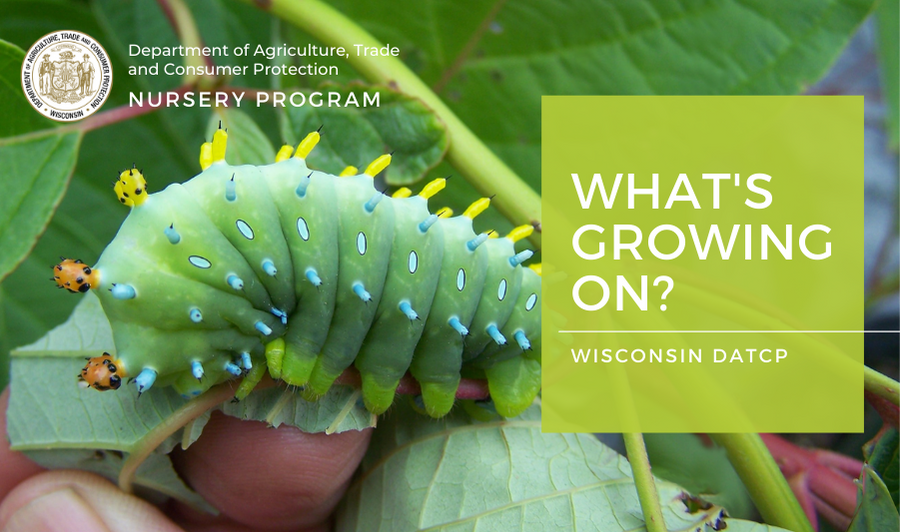 _____________________________________
Dear Wisconsin nurseries, Christmas tree growers, and gardeners:
Degree day accumulations (Simple B50) as of September 14th were 2546 in Madison, 2537 in Racine, 2407 in Green Bay, 1982 in Wausau and 1753 in Crandon. While treatment windows are closing, continue reading for symptoms of many pests and diseases you can still be scouting for to determine management strategies next season.
Take a moment to read through a few updates from the DATCP nursery program. Please send any feedback, questions, or ideas for future e-news updates to datcpnursery@wisconsin.gov.
Having trouble viewing this email? View it as a Web page.
_____________________________________
|
|

As another growing season winds down and perennial stock is sold or senescing, there are still tiny living things left behind in areas that are not easily noticeable. These tiny things are plant pathogens and they may be inhabiting your tools and work areas. Unnoticed plant pathogens left to overwinter in your nursery may not seem like a big deal, but their presence can have a noticeable impact on the health of your stock next season.
Some plant pathogens spend part of their lifecycle on dead leaves, stems, fruits, roots, or in the soil. Common pathogens seen in the nursery industry include fungi (e.g., rusts, anthracnose and other leaf spots, Verticillium wilt), bacteria (e.g., Pseudomonas blight, fire blight),, viruses, and nematodes (e.g., foliar and root). If not properly cleaned, some of this dead plant material or the pathogens may be left on tools and in work areas. Therefore, cleaning up your nursery by implementing straightforward sanitation practices is critical for keeping a healthy nursery.
While it would be ideal to consistently clean up dead plant material throughout the growing season, if that is not practical, then be sure to clean it all up in the off-season. Dead plant material (dead plants, fallen leaves, stems, pruned off branches, fruits, and soil) can be burned or buried to minimize the risk of re-infection the following season. Composting is also an option as long proper internal temperatures are met to sufficiently kill plant pathogens. If left around the nursery, spring rains can splash the pathogens living on the dead material onto the new plants and cause new infections.
For disinfecting tools and surfaces, rubbing alcohol is one of the most effective agents. Brian Hudelson of the University of Wisconsin Plant Disease Diagnostics Clinic describes good sanitation practices in the blog Plant Disease Pointers: “Commercial disinfectants come in many forms. I look for products that contain alcohol (you may see ethanol listed as an ingredient) and where the percentage of all active ingredients is as close to 70% as possible. If you opt to use a spray disinfectant, spray items until they drip and then allow them to air dry.” Tools, equipment, and work areas should be disinfected after working on a single species.
Regardless of the sanitation schedule or which disinfectant product you choose, being conscientious about sanitation and disinfection is essential for preventing the spread of disease-causing pathogens and keeping plants as healthy as possible.
|
_____________________________________
|
|
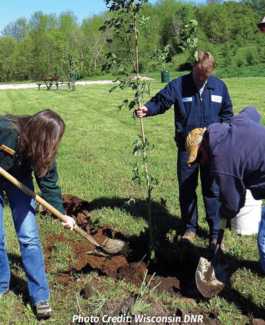
The Wisconsin Department of Natural Resources (DNR) recently released the Results of the 2020 Diverse Urban Species Survey. This publication reports on a survey of the planting preferences and experiences of Wisconsin municipalities.
Communities were asked a series of questions about the types of trees they prefer to plant (such as root stock type and caliper size), which lesser-used species they had successfully planted, which species they cannot find but would like to plant and whether they use a gravel bed. One-hundred seventy communities completed surveys.
Several findings of this survey may be of interest to Wisconsin nursery growers. For instance, responses identified lesser-used species that are in demand and in short supply, which may provide an opportunity to tailor your current efforts to meet a demand you may not have known about.
While continuing to support the planting of existing nursery stock, we are hoping to gradually increase the species and genetic diversity of Wisconsin’s urban forests. Growing and planting a greater number of species creates a more resilient urban forest less affected by any single pest or disease threat.
A digital version of the publication is available online on the DNR’s Urban Tree Planting Resources webpage: https://dnr.wisconsin.gov/topic/urbanforests/treeplantingresources.
If you have questions, comments or would like to request a paper copy of the report, please contact DNR Urban Forestry Coordinator Patricia Lindquist at 715-574-1314 or patricia.lindquist@wisconsin.gov. We would especially like to hear about any barriers you may be experiencing that limit your species offerings, and we will try to help.
|
_____________________________________
|
|
|
The season for cut trees, wreaths, and holiday decor will soon be upon us. Wisconsin is fourth in the nation in sales value of cut Christmas trees. To help keep this commodity clean and healthy, here are a selection of pests and diseases found in evergreen trees for both nursery and Christmas tree providers to be scouting for.
Pests:
- Pine Shoot beetle (Tomicus piniperda) causes broken (aka flagged) shoots with cream-colored pitch at the circular entrance hole. When inspecting in fall, an adult beetle may be present in the hollow shoot.
- European Pine Shoot Moth (Rhyacionia buoliana) stresses the tree leading to no new needle expansion, drooping, damaged, or deformed shoots with pitch present. Also, when inspecting, pink-orange larva could be present in the bud.
- An indicator of Eastern Pine Shoot Borer (Eucosma gloriola) is the frass-filled shoots and oval exit holes left behind. They can attack the terminal leader of the tree but tend to be gone by the fall, leaving no larva or adult for confirmation.
|
|
|
Pine shoot beetle pitch tube | DATCP image
|
|
European pine shoot moth larva | Mariusz Sobieski, Bugwood.org
|
|
|
Diseases:
- Rhizosphaera is a fungus that results in needle cast in spruce (Rhizosphaera kalkhoffii) and needle blight in fir (Rhizosphaera pini) trees. Spruce symptoms include yellow, tan, or purple-brown old needles starting at the tree's base and moving upward. Black fungal fruiting bodies in a line with a white waxy cap may be visible on needles. On blue spruce, purplish brown, diseased needles tend to fall off. Stigmina needle cast disease causes similar symptoms. On fir, R. pini causes tiny black fungal spots to form on needle undersides, and scattered greyish-tan dead needles on branches.
- Phomopsis tip blight and canker is a common fungal disease of conifers in Wisconsin affecting cedar, juniper, arborvitae, fir, larch, and jack pine. The fungus causes brown or purple-brown needles leading to needle-drop from live branches and wilted to dead branch tips. As the disease progresses, cankers develop on older dead/dying branches with black fungal fruiting bodies that may have white/cream oozing.
- Phytophthora root rot is a water mold that affects spruce, pine, and fir trees, causing needles to become yellow or red-brown with stunted growth, wilting, and tree death. Infected trees will have reduced root mass and blackened roots. This disease commonly occurs when stock is planted in low-lying or poorly drained areas. See our 2015 Phytophthora survey report for more details on phytophthora in Christmas tree plantings.
|
|
|
Rhizosphaera needle cast on spruce | DATCP image
|
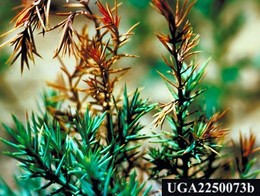 Tip dieback caused by Phomopsis | USDA Forest Service, Bugwood.org
|
|
|
_____________________________________
|
|
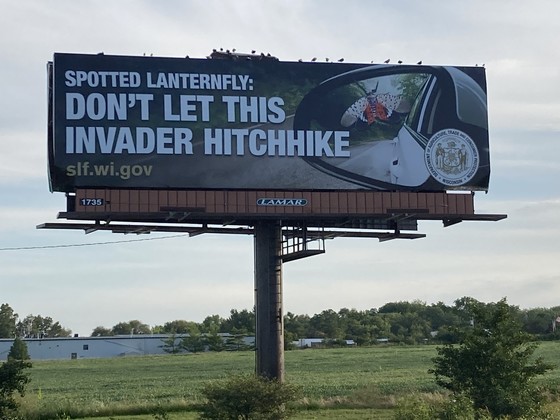 Spotted Lanternfly billboard in southeast Wisconsin | DATCP M. Wensing
Spotted Lanternfly (Lycorma delicatula), or SLF, is an invasive planthopper insect that threatens grapevines, hops, roses and other nursery plants. Native to China, India, Japan and Vietnam, it is invasive in the United States and has now been found in Connecticut, Delaware, Indiana, Maryland, Massachusetts, New Jersey, New York, North Carolina, Ohio, Pennsylvania, Virginia, West Virginia and most recently, Michigan in August. SLF infestations were also found to have spread into northeastern Indiana from the southern part of the state in July.
During the 2022 field season, DATCP staff set 40 SLF traps in Kenosha, Milwaukee and Racine counties and are conducting visual surveys at sites where the preferred host, Ailanthus altissima (tree-of-heaven) has been documented. SLF has not yet been found in Wisconsin. If you are in SE WI in September watch for DATCP’s SLF billboards that were put up in Racine and Milwaukee.
Adult spotted lanternflies are one-inch long and active from Aug. – Nov., or until the first freeze. Adults often rest with their wings closed, appearing pinkish-beige with black dots. When their wings open the bright red hind wings are visible. Spotted lanternflies lay egg masses from September to first freeze. Egg masses may be white or light grey, shiny and putty-like in the fall, before turning dull gray and cracked in winter. Beneath the egg mass covering are rows of eggs. Egg masses are oval and 1 -1.5” long. Females will lay eggs on almost anything, from trees to rocks to cars or other outdoor items. Egg masses can be scraped off and disposed into rubbing alcohol. Nymphs and adults can just be squashed.
If you suspect that you have found SLF in Wisconsin, please report it immediately by filling out the reporting form linked on our webpage at slf.wi.gov with the detection location, images & your contact information.
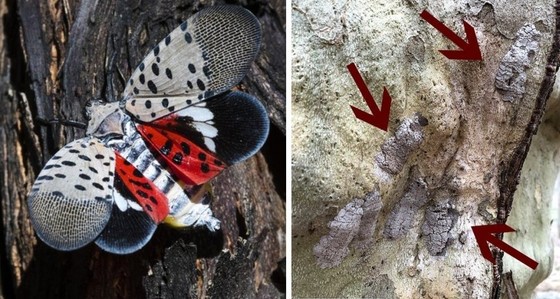 Left: Spotted lanternfly adult, Right: Spotted lanternfly egg masses | AP IMAGES / @VCMCGUIRE
_____________________________________
|
|
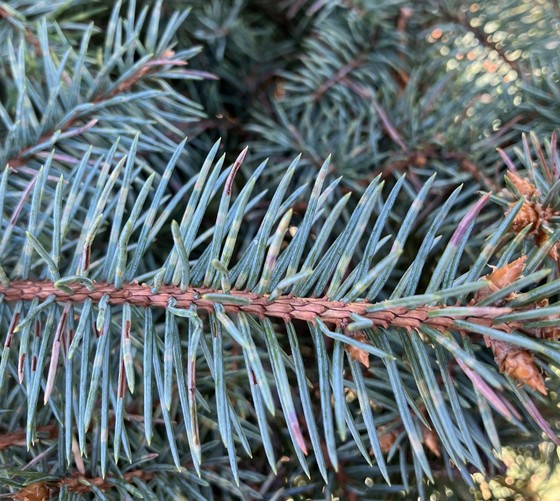 Yellow spots on spruce needles indicating Weir's Cushion Rust infection | DATCP K. Jerabek
Weir's Cushion Rust, a needle disease, is just starting to show symptoms of yellow spots on the current year’s spruce needles now, more noticeable in the lower half of the tree. Whether you are growing Colorado Blue Spruce for a landscape tree or a Christmas tree, tightly branched and densely grown spruce are susceptible to several fungal diseases, including Weir's Cushion Rust disease.
With limited air circulation, spruce needles stay wet too long. Weir's Cushion Rust first infects new needles in May. These needles will show yellow spots by fall. The following May, infecting rust spores emerge. Rust spores can be easily blown onto nearby spruce immediately infecting new needles. The infected needles will fall off, leaving bare spots along the shoots. This rust disease can spend its’ entire life cycle on spruce and, if not controlled, can pretty quickly infect a whole field block. All heights of spruce are susceptible to these rust spores. If you have smaller 3 foot Colorado Blue Spruce growing in a field with larger Colorado Blue Spruce nearby, the rust can easily move into the smaller trees if their needles stay moist.
Weir's Cushion Rust is a serious fungal disease and spruce showing symptoms should not be dug and sold as landscape trees. Managing this rust disease requires multiple fungicide treatments timed when new growth is just emerging and just after elongation and repeated for two years in a row to try to get ahead-of and prevent new infections. You should treat nearby non-symptomatic spruce as well as those showing symptoms. If you choose not to treat, the loss of needles and declining quality of tree needles will make them unsaleable as landscape trees or Christmas trees.
There is a window of opportunity now in the fall, to decide your management options. As a landscape tree grower, you can cull those trees showing symptoms before the end of April and/or you can choose to treat with a fungicide program, while increasing air flow in field block by controlling weeds and grasses around the trees. Trees infected with Weir's Cushion Rust cannot be sold as landscape trees and must be treated to control the disease, which is at least a two year process, or they must be destroyed. If plants are for Christmas tree use, cutting heavy this fall for Christmas tree sales would help remove infected trees. If left unchecked, once infected needles have fallen off two years in a row, tree quality is lost. Weir’s Cushion Rust can infect other spruce species when poor air circulation exists. Scouting for yellow spot symptoms in the fall and keeping good air circulation around spruce is good preventative practice.
_____________________________________
|
|
|
Modeling map showing 99% Spongy moth death by week | DATCP M. Falk
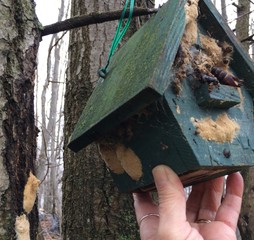
For much of southern Wisconsin, Spongy moth (Lymantria dispar), formerly known as gypsy moth, are now done laying egg masses for the year and are dead.
Once your local spongy moth populations have died, you can begin scouting your outdoors for their egg masses. They'll be in this egg mass stage now till they begin to hatch out next May.
If you live in an area with a low population of spongy moth, it's worth removing egg masses by scraping them into a bucket of soapy water or spraying them heavily with an approved horticultural oil. Each egg mass can contain up to 1,000 eggs that can develop into defoliating caterpillars.
If you live in an area that is more heavily infested, especially if you intend move stock or other regulated articles out of the spongy moth quarantine, you will need a more thorough management plan.
|
|
|
|
_____________________________________
|
|
|
|
|